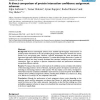Free Online Productivity Tools
i2Speak
i2Symbol
i2OCR
iTex2Img
iWeb2Print
iWeb2Shot
i2Type
iPdf2Split
iPdf2Merge
i2Bopomofo
i2Arabic
i2Style
i2Image
i2PDF
iLatex2Rtf
Sci2ools
BMCBI
2006
2006
A direct comparison of protein interaction confidence assignment schemes
Background: Recent technological advances have enabled high-throughput measurements of protein-protein interactions in the cell, producing large protein interaction networks for various species at an ever-growing pace. However, common technologies like yeast two-hybrid may experience high rates of false positive detection. To combat false positive discoveries, a number of different methods have been recently developed that associate confidence scores with protein interactions. Here, we perform a rigorous comparative analysis and performance assessment among these different methods. Results: We measure the extent to which each set of confidence scores correlates with similarity of the interacting proteins in terms of function, expression, pattern of sequence conservation, and homology to interacting proteins in other species. We also employ a new metric, the Signal-toNoise Ratio of protein complexes embedded in each network, to assess the power of the different methods. Seven confidenc...
BMCBI 2006 | Et Al | Protein | Protein Interaction |
| Added | 10 Dec 2010 |
| Updated | 10 Dec 2010 |
| Type | Journal |
| Year | 2006 |
| Where | BMCBI |
| Authors | Silpa Suthram, Tomer Shlomi, Eytan Ruppin, Roded Sharan, Trey Ideker |
Comments (0)

